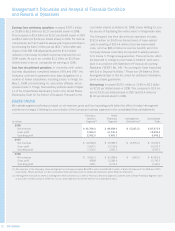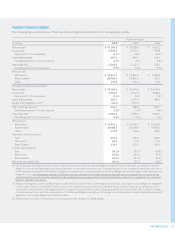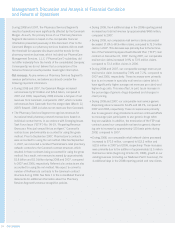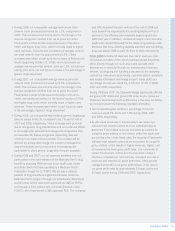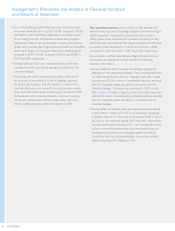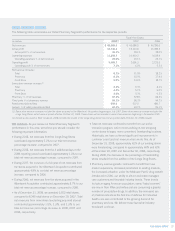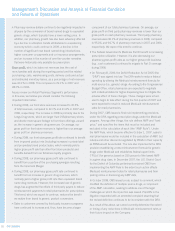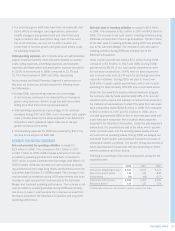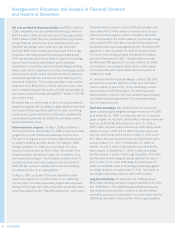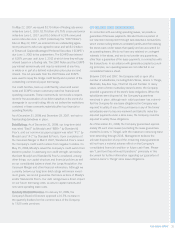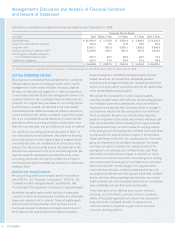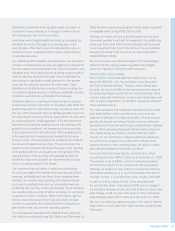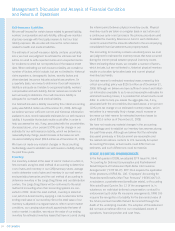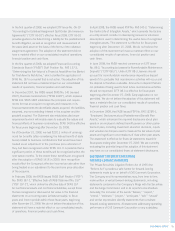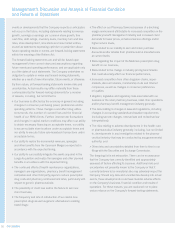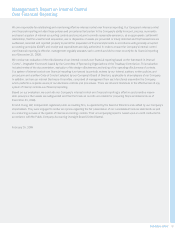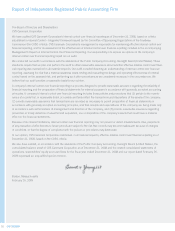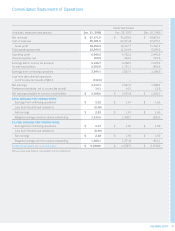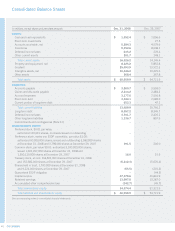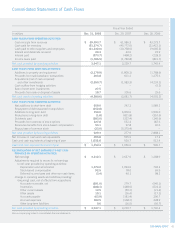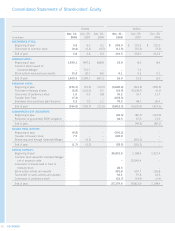CVS 2008 Annual Report Download - page 36
Download and view the complete annual report
Please find page 36 of the 2008 CVS annual report below. You can navigate through the pages in the report by either clicking on the pages listed below, or by using the keyword search tool below to find specific information within the annual report.
32 CVS CAREMARK
Management’s Discussion and Analysis of Financial Condition
and Results of Operations
CRITICAL ACCOUNTING POLICIES
We prepare our consolidated fi nancial statements in conformity
with generally accepted accounting principles, which require
management to make certain estimates and apply judgment.
We base our estimates and judgments on historical experience,
current trends and other factors that management believes to be
important at the time the consolidated fi nancial statements are
prepared. On a regular basis, we review our accounting policies
and how they are applied and disclosed in our consolidated
fi nancial statements. While we believe the historical experience,
current trends and other factors considered, support the prepara-
tion of our consolidated fi nancial statements in conformity with
generally accepted accounting principles, actual results could
differ from our estimates, and such differences could be material.
Our signifi cant accounting policies are discussed in Note 1 to
our consolidated fi nancial statements. We believe the following
accounting policies include a higher degree of judgment and/or
complexity and, thus, are considered to be critical accounting
policies. The critical accounting policies discussed later in this
document are applicable to both of our business segments. We
have discussed the development and selection of our critical
accounting policies with the Audit Committee of our Board of
Directors and the Audit Committee has reviewed our disclosures
relating to them.
Goodwill and Intangible Assets
We account for goodwill and intangible assets in accordance
with SFAS No. 141, “Business Combinations,” SFAS No. 142,
“Goodwill and Other Intangible Assets” and SFAS No. 144,
“Accounting for the Impairment or Disposal of Long-Lived Assets.”
Identifi able intangible assets consist primarily of trademarks,
customer contracts and relationships, favorable and unfavorable
leases and covenants not to compete. These intangible assets
arise primarily from the allocation of the purchase price of
businesses acquired to identifi able intangible assets based on
their respective fair market values at the date of acquisition.
Amounts assigned to identifi able intangible assets, and their
related useful lives, are derived from established valuation
techniques and management estimates. Goodwill represents the
excess of amounts paid for acquisitions over the fair market value
of the net identifi able assets acquired.
We evaluate the recoverability of certain long-lived assets,
including intangible assets with fi nite lives, but excluding goodwill
and intangible assets with indefi nite lives, which are tested for
impairment using separate tests, whenever events or changes in
circumstances indicate that the carrying value of an asset may
not be recoverable. We group and evaluate these long-lived
assets for impairment at the lowest level at which individual cash
fl ows can be identifi ed. When evaluating these long-lived assets
for potential impairment, we fi rst compare the carrying amount
of the asset group to the asset group’s estimated future cash fl ows
(undiscounted and without interest charges). If the estimated
future cash fl ows are less than the carrying amount of the asset
group, an impairment loss calculation is prepared. The impair-
ment loss calculation compares the carrying amount of the
asset group to the asset group’s estimated future cash fl ows
(discounted and with interest charges). If required, an impair-
ment loss is recorded for the portion of the asset group’s carrying
value that exceeds the asset group’s estimated future cash fl ows
(discounted and with interest charges). Our long-lived asset
impairment loss calculation contains uncertainty since we must
use judgment to estimate each asset group’s future sales, profi tabil-
ity and cash fl ows. When preparing these estimates, we consider
historical results and current operating trends and our consolidated
sales, profi tability and cash fl ow results and forecasts.
These estimates can be affected by a number of factors
including, but not limited to, general economic conditions,
efforts of third party organizations to reduce their prescription
drug costs and/or increased member co-payments, the
continued efforts of competitors to gain market share and
consumer spending patterns.
Following is a summary of our signifi cant contractual obligations as of December 31, 2008:
Payments Due by Period
In millions Total Within 1 Year 1-3 Years 3-5 Years After 5 Years
Operating leases $ 23,294.6 $ 1,744.2 $ 3,463.4 $ 3,266.0 $ 14,821.0
Leases from discontinued operations 214.4 2.4 37.8 78.0 96.2
Long-term debt 8,557.1 651.3 2,903.1 1,002.2 4,000.5
Interest payments on long-term debt(1) 3,209.8 442.7 801.3 637.0 1,328.8
Other long-term liabilities refl ected in
our consolidated balance sheet 163.0 40.3 22.4 24.7 75.6
Capital lease obligations 169.9 17.0 34.4 35.5 83.0
$ 35,608.8 $ 2,897.9 $ 7,262.4 $ 5,043.4 $ 20,405.1
(1) Interest payments on long-term debt are calculated on outstanding balances and interest rates in effect on December 31, 2008.


